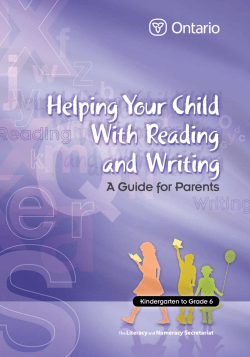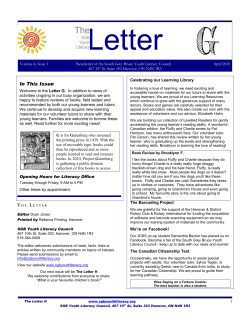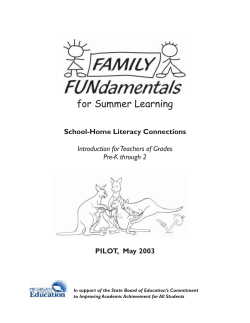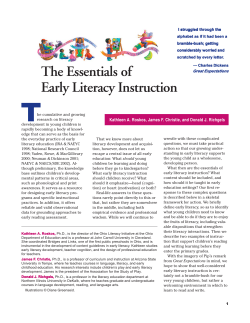
Research-Based Preschool Early Literacy Curriculum i station Reading Curriculum
Research-Based Preschool Early Literacy Curriculum istation Reading Curriculum White Paper August 2006 8150 North Central Expressway, Suite 2000 • Dallas, TX 75206 • 866.883.7323 • fax: 972.643.3441 • www.istation.com Recent reviews of the research on language and literacy provide overwhelming evidence that quality preschool language and early literacy experiences have far reaching effects (Bowman et al 2000; NIFL, 2004; NRP 2002; Strickland and Shanahan, 2004). These studies identify the key language and literacy skills that young children need to learn, environments that facilitate skills development, and interventions that support later academic success. The convergence of evidence provides clear direction for preschool programs, teachers, and curriculum developers. Children with strong skills in the following four areas are those most likely to become successful readers: 1. 2. 3. 4. Alphabetic knowledge Phonological awareness Print Awareness Oral language Effective interventions, those that show statistically significant positive effects on reading outcomes, include the teaching of sounds and letters, helping children make sense of print, reading to and sharing books with young children, as well as direct efforts to teach oral language. istation Reading Curriculum delivers explicit systematic instruction in critical components identified by Early Reading First and NAEYC Standards. istation Reading Curriculum’s literacy instruction is strengthened by the infusion of Internet-delivered technology. This highly engaging multimedia curriculum uses animated characters, music, games, books and activities to provide supplementary, individualized instruction. Online assessment and continuous progress monitoring ensure instruction is data-informed and specific to each child’s needs. Initial research on the effectiveness of istation Reading Curriculum compared more than 30 preschool classrooms in two urban school districts that used a common preschool curriculum. Results show significantly higher performance on CIRCLE assessments of children who use istation Reading Curriculum as a supplement to the core curriculum. In this study, children showing the greatest improvement were preschool English language learners who used the core curriculum plus istation Reading Curriculum Foundations (Pre-K) Level. 8150 North Central Expressway, Suite 2000 • Dallas, TX 75206 • 866.883.7323 • fax: 972.643.3441 • www.istation.com Research-based early Literacy Findings Alphabetic Knowledge • Letter recognition • ABC order • Sound/ symbol correspondence istation Reading Curriclum istation Reading Curriculum provides activities for children to say and sing letter names, name letters, produce and identify letters, and associate letters with pictures and sounds. In addition, children learn the order of the alphabet, identify and produce upper and lowercase letters, and associate words that begin with the same initial sound as the letter. Teacher resources provide small group and center extension activities linked with each skill. These activities link the online program with direct teaching in the classroom through teacher involvement. Phonological Awareness • Word boundaries • Syllable identification • Rhyming words and phrases • Onsets and rimes • Phoneme identification and manipulation Print Awareness • Directionality of print • Title, author, illustrator • Book handling • Words, phrases, letters, capitalization, punctuation Oral Language • Vocabulary development • Listening comprehension • Following directions • Story Comprehension istation Reading Curriculum offers a variety of poems, songs, and alliterative animated stories that provide children with the opportunities to hear and play with rhyming words and phrases. Working from poems and stories, through onset and rime activities, children hear and identify similar sounds and sound patterns. They learn to identify word and syllable boundaries before practicing their phonemic awareness skills with counting phonemes and phoneme manipulation (initial and final substitution). Additional phonemic awareness activities are provided to teachers for use in small group instruction. Book and print awareness instruction and practice activities in the istation Reading Curriculum provide directed lessons in book handling, identifying the book’s title, author, and illustrator. All text, in books, poems, stories, and animations, is highlighted, as the narrator reads each word, thus providing continuous support for learning to read in English from left to right, as well as identifying word and sentence boundaries. Additional book and print awareness activities include specific lessons in identifying capital and lower case letters in a sentence, as well as punctuation marks, their placement and meaning. Each letter/ sound lesson in istation Reading Curriculum provides direct vocabulary instruction through interactive, animated graphics and activities. After completing alphabetic instruction, children have learned 182 new words, seven for each letter/; sound. These words were selected from universal themes of family and home, food, body and clothing, feelings, animals and nature, school and community. All instruction, both pedagogical and directional, is provided through spoken language. Children listen to lessons that are augmented with animation, to help scaffold student listening comprehension. The interactive nature of istation Reading Curriculum requires that children closely attend to directions. Changing venues require children to listen to and follow directions. Peer tutors explain and model to allow children to move through each activity. Narratives, or stories, are the prime genre for early literacy reading in istation Reading Curriculum. Illustrations and animations accompany all stories to aid student comprehension of stories and their structures. 8150 North Central Expressway, Suite 2000 • Dallas, TX 75206 • 866.883.7323 • fax: 972.643.3441 • www.istation.com References Bowman, B., Donovan, M. S., & Burns, M. S. (Eds). (2000). Eager to learn: Education our preschoolers. Washington, DC: National Academy Press. National Institute for Literacy. National Early Literacy Panel: Synthesizing the scientific research on development of early literacy in young children (accessed 7/31/06 http://www.nifl.gov/partnershipforreading/family/ncfl/NELP2006Conference.pdf#xml=http://avs.nifl.gov/ cgi-bin/tesix/webinator/search_site/sml.txt?query=NELP&prox=page&rorder=500&rprox=500&rdfreg=500& rwfreg=500&rlead=500&sufs=0&order=r&cq=7id=4456bd244) National Reading Panel Report. (2000). Teaching children to read. Washington, DC: National Institute of Child Health and Human Development. Stickland, D. S., & Barnett, W. S. (2003). Literacy interventions for preschool children considered at risk: Implications for curriculum professional development, and parent involvement (pp 104-116). National Reading Conference Yearbook Strickland, D. S., & Shanahan, T. (March, 2004). Laying the groundwork for literacy. Educational Leadership (pp 74-77). © istation, 2006 8150 North Central Expressway, Suite 2000 • Dallas, TX 75206 • 866.883.7323 • fax: 972.643.3441 • www.istation.com
© Copyright 2025










